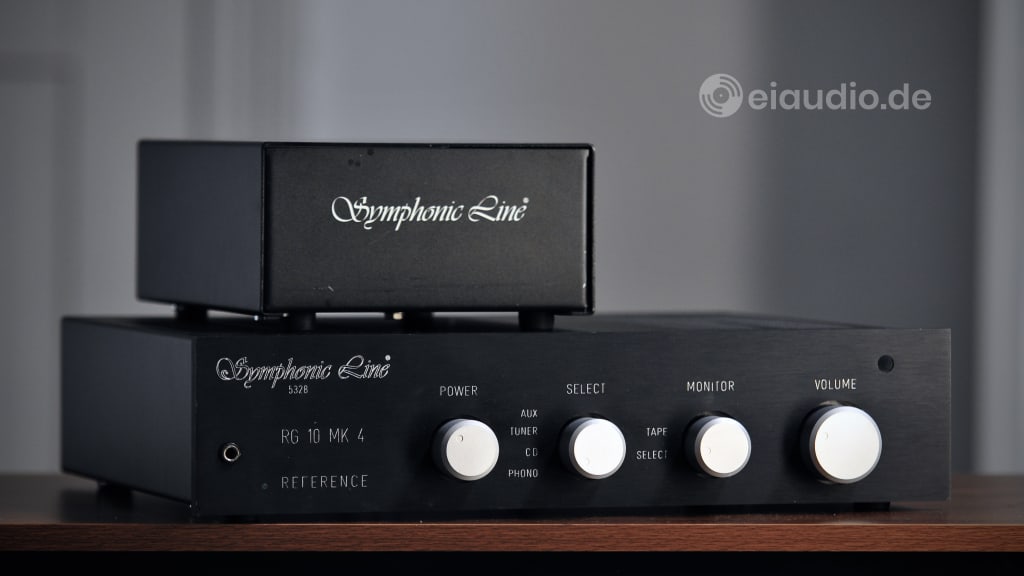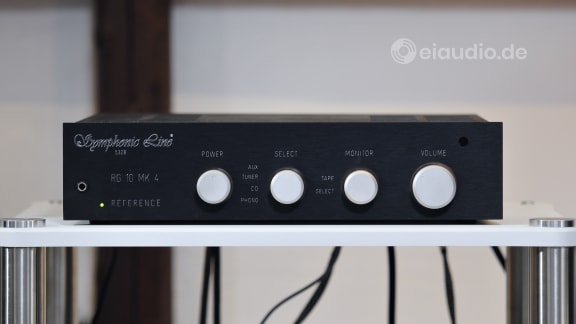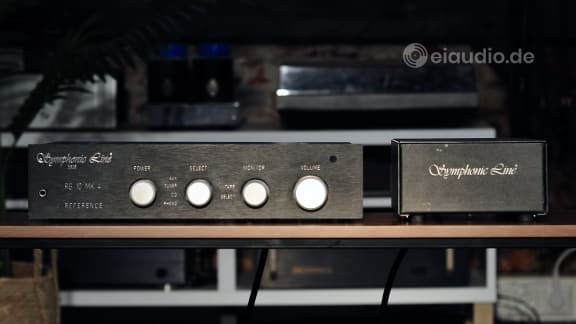Symphonic Line RG10 MK4 Reference
Published: 19/01/2025
Manufacturing date: 2019
Author: Karsten Hein
Category: Gear & Review
Tag(s): Integrated Amplifiers
The Symphonic Line RG10 MK4 Reference integrated amplifier excels in multiple ways. It builds upon the already excellent RG9, and the MK4 version further enhances the design with an external power supply for the upgraded Reference preamplifier module.
The Magic of Exactness.
It is early January 2025. A winter storm is hauling outside. And yet our listening room under the roof feels cosy and warm. I turn on the RG10 amplifier, taking note of the reassuring pong that is produced by its large mumetal transformer jumping into action. The sound is similar to that of a distant gong, ever so slight and just once, as if to acoustically confirm that clean power is now available—in abundance. I cannot help but smile, as I sit down in my favourite listening chair.
When the music starts playing, however, I notice my mistake: Instead of playing Diana Krall's album “Glad Rag Doll”, as I had intended, our Thorens TD320 turntable still has the old “Winter Wonderland” sampler from our eiaudio Christmas session on. And this begins with Dean Martin’s rendition of “Let it snow”. For a moment, I am tempted to get up and change the record, but then I find myself transfixed by the pure and honest sound that is forming between our Martin Logan SL3 electrostatic speakers.
“Winter Wonderland” is a collection of songs from the 1940s through the 1960s, many of which were not yet recorded in stereo. Such old-school recordings have some charm, of course. And with the RG10 MK4 Reference amplifier driving our Martin Logan speakers, the SL3 turn into holographic projectors through which a pulsating and almost tangible phantom centre is created. The image is so clean and beautiful that I am strangely reminded of the old Marantz amplifier oscilloscopes, which were able to derive flower-like visual images from the music signal by wrapping the linear wave form around a circle (see Marantz Model 2600 from 1977). I found myself glued to the chair, unable to change the record, because I was mesmerised by its raw beauty for the first time.
Your Ears See More.
Although it is easy to notice the limitations of the original recordings in such a revealing setup, the tonality and transparency of the system is such that it transcends these limitations, even makes them fun to listen to, and thereby renders them as charming. By laying bare the individual aspects of each recording—timing, transients, dynamics, timbre, tonality, and decay—we are able to comprehend the recording and mastering decisions in all their dimensions and are provided with a larger and more sober view of what was possible and available to the sound engineers and their equipment at that specific time.
When tonal events are presented in defined order, with each having a precise start and finish, the listener is empowered to look beyond the scope of the recording into the vast available spaces that remain unfulfilled by it. The impression is similar to that of looking into a room in which some objects have been positioned. If sufficient lighting and sharpness are given, we can see each object individually with its defined size, shape, texture, and tonal colour, and we can recognise the composition and purpose of the objects taken together. From this, we derive one feeling for the shape and arrangement of the objects and another feeling for the room itself. If a HiFi system provides sufficient order (acoustic properties similar to light and sharpness), it becomes obvious to the ears that the recording and the system potential are two different things.
Original or Imitation?
Following up on my original intension of listening to Diana Krall’s album “Glad Rag Doll”, her song by the same name greeted me with a high noise floor in the form of a constant hissing sound on both channels. This made the position of the loudspeakers visible to the ears and came as a surprise to me, because I had not noticed its presence so clearly in my previous listening sessions with this album. The guitar and Diana’s vocals were both positioned along the phantom center and in an overlapping fashion. This I would have expected from a mono recording of the 1950s or 60s, however, here the music sounded loud and condensed at the same time, as is the fashion today. I was confused by the disparate associations this blend of styles produced.
On “A little mixed up”, the piano appeared tiny in relation to Diana’s vocals. The two guitars were confined to the exact positions of each of the two speakers, a mastering choice I remembered from songs of Elvis and the Beatles, which seemed a bit out of place on a modern record. With “Prairie Lullaby” offering more of the same, it became clear to me that the artistic choices made in the production of this album were somewhat different from Diana Krall’s more audiophile releases. And, while I could accept the album as an attempt to replicate the nostalgia of a long-gone era, the RG10 MK4 Reference HD paired with Martin Logan SL3 speakers exposed the album as being unauthentic and insincere.
It is usually more fun to listen to a poor recording on a great system than it is to listen to a great recording on system that performs poorly. Just as it is more fun to drive slowly in a vehicle with a powerful engine than it is to drive fast in a car that is not made for speed. “Glad Rag Doll” is the exception, however, because it parades as a poor recording by choice. Just like shabby chic furniture will never be classics, the Krall album falls short in a similar way once it is exposed. And, as most audiophiles will agree, once we have heard something, it is impossible to unhear it.
The RG10 MK 4 Reference is an ultra-revealing and superbly crafted amplifier that can easily drive complex speakers. Due to its high current ability, it remains undeterred by the frequency dependant loads of our Martin Logan electrostatic panels. Its two large toroidal transformers offer a combined continuous throughput of 750 watts, and the eight power amplifier capacitors alone provide a staggering 104.000 μF of ultra-fast reserves. This is enough juice to drive complex loads at impressive volumes, something that might not be obvious from looking at the specifications alone.
Keeping Things Together.
Moving on to the album “Adele 30”, I am reminded how beautiful even Pop music can sound if the system is up to the task. Adele’s song “Hold on” gradually builds from tender vocals to full instrumentation. The RG10 MK IV Reference renders this faithfully throughout and reveals a recording that has been made with great care. In “To be loved”, the initial piano keys sound wonderfully rich and alluring. It is easy for me to forget my system and to be immersed in the music. Only occasionally, a click or pop sends a reminder that the record is still spinning, and that the loudspeakers are still there. I am also reminded that this particular album was a gift to my daughter, who tends to leave her records resting on the turntable after playing them. It is the combined effect of dust and moisture that is difficult to remove with a record brush alone.
I like the accomplished look of the RG10 Reference amplifier on the top shelf of our rack. Its separate power supply for the preamplifier sits on the shelf underneath. The four large knobs on the RG10’s dark front visually allude to the sense of superior acoustic order that is so commonly associated with Symphonic Line gear. The RG10 MK4 builds on the original RG9 with each iteration offering refinements over previous models. Founder and chief developer, Rolf Gemein, prioritizes phase linearity, combining it with stringent circuit resonance management. To achieve this, high-quality, industrial-grade components are hand-selected, matched, and assembled by his team in Duisburg, Germany. Each unit undergoes a thorough auditory evaluation and is fine-tuned by Rolf Gemein himself to ensure optimal performance.
Made for Vinyl.
The result of this philosophy is audible. The phono stage of the RG10 Reference amplifier is accomplished to such an extent that I found myself listening to 70% vinyl and 30% CD, which is the exact opposite of my usual listening behaviour. From an audiophile perspective, therefore, I have no complaints. The few aspects that still bother me have to do with the practical handling of the unit, such as night time operation and moving the amplifier around.
As I do most of my listing in the evenings when all the noise around me has subsided, I use only minimal lighting to calm down from a day's work, soothe my nerves, and focus more intently on the music. In this scenario, I often find it difficult to switch between the input sources with assurance. The indentations on the knobs are simply too small for me to determine their current positions. Given their substantial weight, the amplifier and power supply sit too low, making it easy to pinch my fingers when handling them. Higher feet under each device or even a small cavity for the fingers along the sides would improve handling.
The RG10 MK4 Reference HD is a highly accomplished amplifier that measures well and sounds superb. The externally housed Reference power supply for the preamplifier at first may seem like overkill, but in reality, it enhances realism in each recording. The resulting performance is tonally balanced and incredibly revealing, offering a palpable space to the music that extends beyond the music recording itself. For optimum listening conditions, the RG10 MK4 should be connected with excellent cables and be further protected from HF noise infiltrating the system through the power mains and from other sources. For those of us willing to spend the necessary time and money on their setup, the RG10 MK4 Reference offers first-hand insights to recordings that are precious and otherwise hard to come by.
List of test components:
Turntable: Thorens TD320 with AT-540 ML cartridge and external Audiophonics power supply; turntable base: sand-filled wood with Concertmeister Basotec absorbers made by Klaus Finnern; Power cord: Symphonic Line Music Electrical Cable (2021); speaker cables: WSS Platin Line LS4 (hand-crafted by Jochen Bareiß in Nürtingen, Germany in 2024);
Listening Test (on YouTube):
RG10 MK4 Reference
Find out more:
< Symphonic Line RG9 MK3 | Rolf Gemein & High End Society >
Specifications
- Type: Integrated amplifier
- Features: external preamp power supply
- Power output (RMS, 8 Ohms): 120 WPC
- Power output (RMS, 4 Ohms): 190 WPC
- Power when idle: 107 watts
- Phono inputs: 1x MM/MC
- Line inputs: Aux, Tuner, CD, Tape loop
- Line outputs: 1x Pre out, 1x Speakers out
- Speaker binding posts: WBT-0705 CU Nextgen
- Dimensions: (W)450mm x (H)100mm x (D)410mm
- Headphone jack: 3,35mm
- Extras: Infrared remote control + box
- Weight amplifier: 17 kg
- Weight power supply: 8 kg
- Country of manufacture: Germany
- Year(s): 2015





